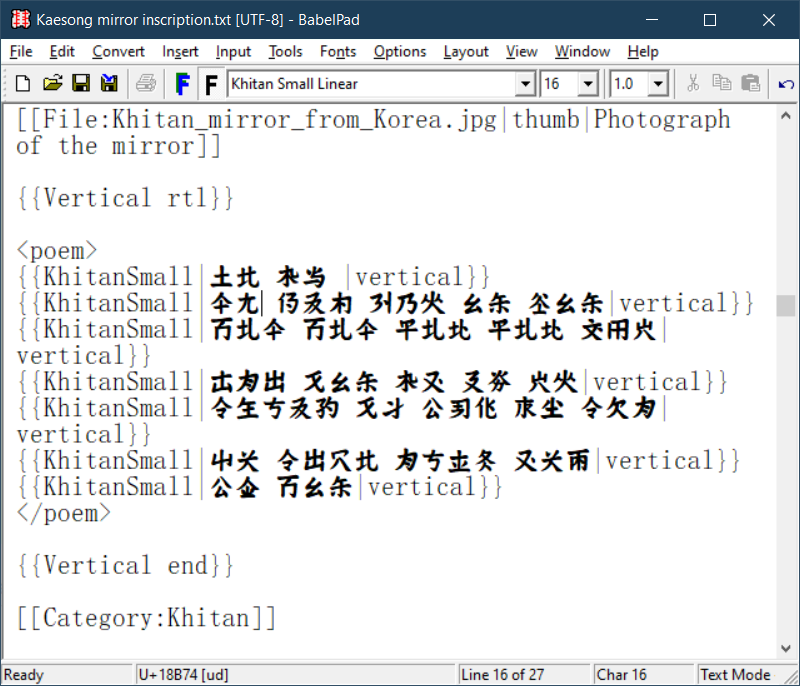
These are three fonts supporting the Khitan Small Script (KSS) which was encoded in Unicode version 13.0 (March 2020). These fonts all use Khitan glyphs designed by Prof. Jǐng Yǒngshí 景永时 of the Beifang Ethnic University (北方民族大学), with additions and modifications by Michael Everson and Andrew West. The glyphs in these fonts should match those shown in the Unicode code chart for Khitan Small Script. This version of the fonts supports Unicode version 16.0, which adds a blank character at U+18CFF in order to represent a missing or illegible character in a cluster (NB At present rendering engines may break a run between U+18CFF and other Khitan characters, resulting in unexpected display).
Khitan Small Linear : Font with no cluster composition, intended for displaying individual glyphs in horizontal linear layout as used in Daniel Kane's The Kitan Language and Script (Brill, 2009).
This font has a single ZWJ ligature for U+18C5B 𘱛 + U+18CD1 𘳑 to display the combined 'good fortune' character 𘱛𘳑 (qudug), which is often treated as a logograph
Example of linear Khitan text in a text editor
Khitan Small Rotated : Font with cluster composition and rotated glyphs, intended for displaying Khitan text in rotated vertical layout. The font glyphs are rotated counterclockwise (as is the case for Mongolian and Phags-pa fonts), and each run of text (e.g. a column of text) should be rotated clockwise using CSS (layout-flow: vertical-ideographic; writing-mode: vertical-rl; vertical-align:top;) or some other higher level protocol. In plain text environments Khitan text will be displayed horizontally left-to-right with glyphs rotated counterclockwise.
This font supports all clusters comprising between two and nine characters in length. It also supports a single ZWJ ligature to display U+18C37 𘰷 + U+18BDF 𘯟 + U+18C64 𘱤 as a single glyph 𘰷𘯟𘱤 (this dubious triple glyph uniquely occurs in the handwritten copy of the Memorial for Empress Renyi 仁懿皇后哀冊, but as the original stone tablet is lost it is impossible to verify whether the triple glyph is genuine or a copying error).
Example of rotated Khitan text on a web page
Source: Wikisource: Kaesong mirror inscription (see also my page here if you do not have Khitan Small Rotated installed)
Example of rotated Khitan text in a text editor
Khitan Small Vertical : Font with cluster composition and upright glyphs, intended for displaying Khitan characters and clusters embedded in horizontal text in another script (e.g. Chinese, English, or Russian). The font glyphs are upright, so do not need rotating, but the font has very tall line spacing in order to fit clusters of up to four storeys in height. This font supports all clusters comprising between two and eight characters in length (the longest attested KSS cluster comprises eight characters).
Example of upright Khitan clusters embedded in English text in Word
Example of upright Khitan text in a text editor
These fonts use the 'DFLT' (default) and 'kits' (Khitan Small Script) script tags with the 'rlig' (Required Ligatures) feature for cluster formation and ZWJ ligatures. The Khitan Small Vertical font additionally uses the 'dist' (Distances) glyph positioning feature to position glyphs within a cluster. Positioning reduces the number of positional glyph forms that are needed in the font (Khitan Small Rotated has five positional forms for each KSS character, whereas Khitan Small Vertical only has three positional forms for each KSS character), so the Khitan Small Rotated font is somewhat larger in size compared with the Khitan Small Vertical font. However, some applications may not position glyphs correctly in vertical orientation, so I deliberately avoid using positioning for Khitan Small Rotated.
A zip archive of all three fonts is available here.